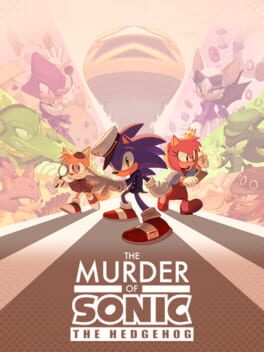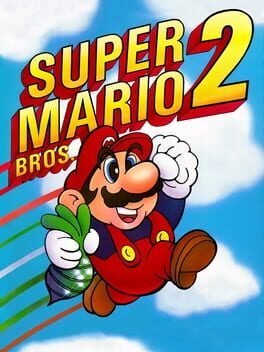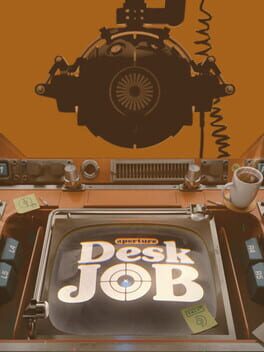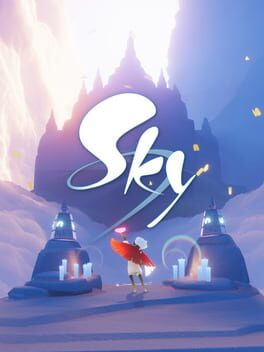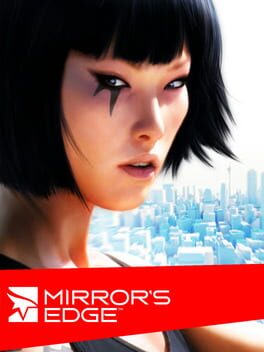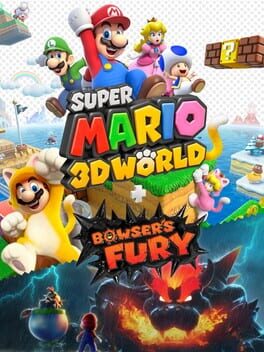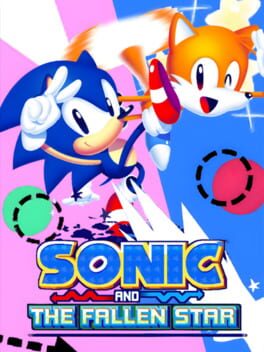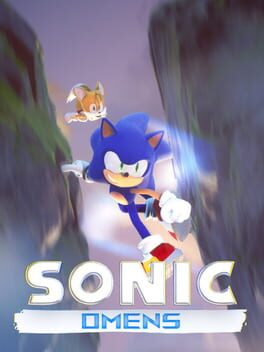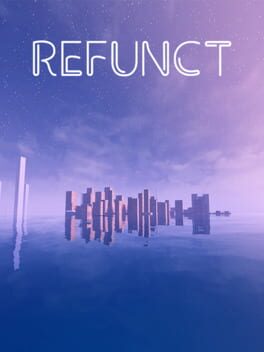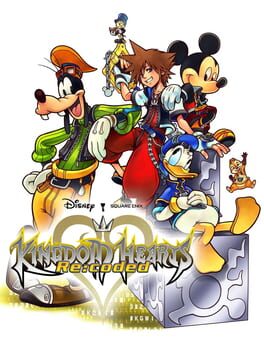Lozicle
The real April Fools Day joke is that this seems like an ironic joke game poking fun at how infamous the franchise has become when in reality it's a genuine labor of love with some of the best character-driven comedic writing in the series. This is a great tribute to the extended Sonic cast, and a fun detective game in its own right.
A shockingly good story for a Pokemon game thanks to its lovable cast, imaginative setting, and literally wonderful tone.
The dungeons start off simple, but they later get more complex with tougher combinations of enemy Pokemon that keep them engaging. Grinding can help, but intelligent resource management and planning can overcome the challenges just as well (my sister told me I was really under-leveled by endgame, and I still got through just fine).
This does cause the pre-mission management to be somewhat tedious though, like a checklist that needs to be done before the fun can begin proper. As charming as all the characters are, watching Spinda shake up my juice can get pretty old, just as an example.
Overall, a charming game that Pokemon and dungeon-crawler fans should try.
The dungeons start off simple, but they later get more complex with tougher combinations of enemy Pokemon that keep them engaging. Grinding can help, but intelligent resource management and planning can overcome the challenges just as well (my sister told me I was really under-leveled by endgame, and I still got through just fine).
This does cause the pre-mission management to be somewhat tedious though, like a checklist that needs to be done before the fun can begin proper. As charming as all the characters are, watching Spinda shake up my juice can get pretty old, just as an example.
Overall, a charming game that Pokemon and dungeon-crawler fans should try.
2021
Annalynn pays homage to classic '80s arcade games like Pac-Man, Donkey Kong, and Mario Bros. It takes dot collecting, multi-colored enemies, and temporary power-ups from Pac-Man. The differing levels and jumping action are from Donkey Kong. Enemy-kicking feels right out of Mario Bros. I can't say Annalynn is as elegant as those games, nor that it establishes an identity distinct from them, but it's about as addictive as them and substantially more approachable.
The aesthetics are on-point. The visuals call back to the art found in the arcades, albeit with some nice enhancements (characters have more frames of animation, for example). The music uses an arcade-like soundfont, but it's written like later NES games. And it slaps. Sound effects are also pleasant, and they punctuate the action well. The presentation makes the game feel like a throwback done right, but it has its own additions too.
The characters are appealing and presented with a ton of charm thanks to the way they're shown in cutscenes between levels. Like in Pac-Man, a short scene will play every few levels, one before each new area. Not only do these flesh out the context, they sometimes introduce new hazards that will appear in the next set of levels. Thus, levels can be more concise, as the player can start playing with immediate knowledge of what to expect. It stops doing this after Round 9 until Round 16, however. Instead, those cutscenes just show cute shenanigans. They feel like a missed opportunity.
The controls are responsive, with a modern feeling jump that can be adjusted in mid-air. The core design feels modern too, but in a way that detracts from the retro feel. Information is sometimes hidden, with the snakes popping in and out of holes or getting scrolled off-screen. This sometimes leads to the player getting caught off-guard. Older arcade games often kept all the information they could handle on-screen at all times. Hiding the snakes this way can sometimes lead to frustrations, either with them suddenly coming out of a hole or not knowing where the last one is while they're dazed.
Annalynn's homages to the classics can hurt its ability to set itself apart as well. It takes many ideas from arcade greats but doesn't leave much to say for itself. It does have more level variety than games from back then, but the level themes are reminiscent of ones from NES games (Rounds 7-9 for example feel like something out of Mega Man 2). The game puts a heavy focus on making its cast appealing, but, well, this is a game with four, colorful, big-eyed enemies that get scared and start flashing blue after the player collects a large item. Which game am I talking about? That said, I guess making something with a new spin on Pac-Man is better than a lot of other '80s arcade games managed. There's enough room for Annalynn too.
The best thing Annalynn has going for it is its approachability. The game can get tricky in later Rounds, but there are infinite continues, with the player's score getting cut in half being the only punishment. This means most of the game's content is available to anyone who just wants to jump around collecting coins and kicking snakes. This doesn't make the game toothless though. Some achievements and unlocks require striving for perfection. To help get players ready for mastering the game, beating a level once unlocks the ability to play it in Practice mode. Getting a Perfect Clear in Practice mode even counts towards some unlocks. This balance of tough challenges and accommodations for approachability makes the game easy to go back to over and over again.
The aesthetics are on-point. The visuals call back to the art found in the arcades, albeit with some nice enhancements (characters have more frames of animation, for example). The music uses an arcade-like soundfont, but it's written like later NES games. And it slaps. Sound effects are also pleasant, and they punctuate the action well. The presentation makes the game feel like a throwback done right, but it has its own additions too.
The characters are appealing and presented with a ton of charm thanks to the way they're shown in cutscenes between levels. Like in Pac-Man, a short scene will play every few levels, one before each new area. Not only do these flesh out the context, they sometimes introduce new hazards that will appear in the next set of levels. Thus, levels can be more concise, as the player can start playing with immediate knowledge of what to expect. It stops doing this after Round 9 until Round 16, however. Instead, those cutscenes just show cute shenanigans. They feel like a missed opportunity.
The controls are responsive, with a modern feeling jump that can be adjusted in mid-air. The core design feels modern too, but in a way that detracts from the retro feel. Information is sometimes hidden, with the snakes popping in and out of holes or getting scrolled off-screen. This sometimes leads to the player getting caught off-guard. Older arcade games often kept all the information they could handle on-screen at all times. Hiding the snakes this way can sometimes lead to frustrations, either with them suddenly coming out of a hole or not knowing where the last one is while they're dazed.
Annalynn's homages to the classics can hurt its ability to set itself apart as well. It takes many ideas from arcade greats but doesn't leave much to say for itself. It does have more level variety than games from back then, but the level themes are reminiscent of ones from NES games (Rounds 7-9 for example feel like something out of Mega Man 2). The game puts a heavy focus on making its cast appealing, but, well, this is a game with four, colorful, big-eyed enemies that get scared and start flashing blue after the player collects a large item. Which game am I talking about? That said, I guess making something with a new spin on Pac-Man is better than a lot of other '80s arcade games managed. There's enough room for Annalynn too.
The best thing Annalynn has going for it is its approachability. The game can get tricky in later Rounds, but there are infinite continues, with the player's score getting cut in half being the only punishment. This means most of the game's content is available to anyone who just wants to jump around collecting coins and kicking snakes. This doesn't make the game toothless though. Some achievements and unlocks require striving for perfection. To help get players ready for mastering the game, beating a level once unlocks the ability to play it in Practice mode. Getting a Perfect Clear in Practice mode even counts towards some unlocks. This balance of tough challenges and accommodations for approachability makes the game easy to go back to over and over again.
HAL's experimented with 3D Kirby before, but this is Kirby's first full adventure in 3D, and they nailed it. The levels, puzzles, powers, game feel, and bosses are all authentically Kirby. In fact, it feels so much like a Kirby game, it's kinda weird to me how much praise it's getting compared to other recent entries. It can't just be the new perspective, right? Clearly the game makes some clever changes to the formula. I can think of a few.
I have a much easier time remembering the levels themselves in this game. Part of that is them being 3D and thus more spatially involving. Part of it is how aesthetically distinct they are from previous Kirby games. Most of all, it's the missions forcing me to engage with them more than ever before. Sure, other games involved searching levels or overcoming challenges for macguffins, but the missions have more character and are tied more to the environment rather than just the level structure. Reaching the end of the level and seeing that one of the missions was "Remove the wanted poster" made me not only pay more attention next time I played that level, but I paid more attention to posters in later levels too, just in case.
Thoroughly exploring the levels for secrets also creates part of an engaging loop with the Waddle Dee Town. In previous games, collectables were mostly limited to providing extra lives, unlocking levels, or offering aesthetic novelties. While Forgotten Land has collectables like that, the Waddle Dees and Blueprints also incentivize the player to revisit the growing Waddle Dee Town. There, the player can see how the saved Waddle Dees have built the town with facilities like the Café for healing on-the-go, use the Blueprints to upgrade copy abilities, and spend leftover star coins at the gotcha machines. This creates a satisfying loop of completing the levels, returning to the town to use what was collected, and progressing to the next level to find more Waddle Dees (and to use the upgraded copy abilities).
The town also adds to the theming and cohesion. Despite being in a new world, being able to return to a home away from home at any time keeps the game feeling cozy. Mini-games and side activities that were previously accessed through a menu are now just places in the town that the Waddle Dees also enjoy, making it all feel like part of one holistic experience.
I have a much easier time remembering the levels themselves in this game. Part of that is them being 3D and thus more spatially involving. Part of it is how aesthetically distinct they are from previous Kirby games. Most of all, it's the missions forcing me to engage with them more than ever before. Sure, other games involved searching levels or overcoming challenges for macguffins, but the missions have more character and are tied more to the environment rather than just the level structure. Reaching the end of the level and seeing that one of the missions was "Remove the wanted poster" made me not only pay more attention next time I played that level, but I paid more attention to posters in later levels too, just in case.
Thoroughly exploring the levels for secrets also creates part of an engaging loop with the Waddle Dee Town. In previous games, collectables were mostly limited to providing extra lives, unlocking levels, or offering aesthetic novelties. While Forgotten Land has collectables like that, the Waddle Dees and Blueprints also incentivize the player to revisit the growing Waddle Dee Town. There, the player can see how the saved Waddle Dees have built the town with facilities like the Café for healing on-the-go, use the Blueprints to upgrade copy abilities, and spend leftover star coins at the gotcha machines. This creates a satisfying loop of completing the levels, returning to the town to use what was collected, and progressing to the next level to find more Waddle Dees (and to use the upgraded copy abilities).
The town also adds to the theming and cohesion. Despite being in a new world, being able to return to a home away from home at any time keeps the game feeling cozy. Mini-games and side activities that were previously accessed through a menu are now just places in the town that the Waddle Dees also enjoy, making it all feel like part of one holistic experience.
1988
2022
2012
Not so much an "emotion experience" as it is a game that effectively facilitates players creating their own through their interactions with the environment and other players.
For example, I came across another player pretty early on, and we decided to stick together. We helped each other find our way through each set of obstacles until we reached the snowy mountain. We stayed close to each other, pushing through the wind and climbing up the cliffs. At one point, they fell from one of the cliffs, far enough that the trip back would take a considerable amount of time. I stood there for a solid minute, debating with myself on whether I should go on without them. I eventually climbed back down to accompany them. Later, they fell from a different cliff, completely out of sight this time. I stood there for about five minutes calling out to them. The snow storm was so dense and loud that I'm not sure I would have been able to tell if they were coming back. Eventually, I had to move on without them. Reaching the top of the mountain was bittersweet.
For example, I came across another player pretty early on, and we decided to stick together. We helped each other find our way through each set of obstacles until we reached the snowy mountain. We stayed close to each other, pushing through the wind and climbing up the cliffs. At one point, they fell from one of the cliffs, far enough that the trip back would take a considerable amount of time. I stood there for a solid minute, debating with myself on whether I should go on without them. I eventually climbed back down to accompany them. Later, they fell from a different cliff, completely out of sight this time. I stood there for about five minutes calling out to them. The snow storm was so dense and loud that I'm not sure I would have been able to tell if they were coming back. Eventually, I had to move on without them. Reaching the top of the mountain was bittersweet.
This is just free-to-play, grindy Journey. Still absolutely beautiful, but playing both reveals just how derivative Sky is of its older sibling.
I played Sky first, and it's like Thatgamecompany knew I hadn't played Journey yet, so they just made a version of Journey that suited my tastes more. Flying through an ocean of clouds; varied, colorful environments; available on a device I own; character customization; free.
Those last two parts contribute to my one problem with Sky though. Getting parts to customize my character with requires getting flames from candle sticks. They respawn every day, so this encourages playing the game every single day or paying money to get them right away. I prefer staying a free player, and I don't think this game benefits from frequent revisits. Thankfully, the game has received updates over time that add new content. Those at least warrant revisits.
It's a shame then that I ended up replaying Sky's main story by way of Journey's PC release. Maybe that's unfair. They aren't exactly the same, but the way both games present their stories are so similar, it's impossible not to draw comparisons. Start from the bottom and work your way upward; encounter other travelers and potentially make friends; hide from scary, flying monsters; ascend. Sky has its own things it's doing differently, but it still feels like a retread.
Sky is still a game that everyone should try (it is free), but I don't respect it like I do Journey.
I played Sky first, and it's like Thatgamecompany knew I hadn't played Journey yet, so they just made a version of Journey that suited my tastes more. Flying through an ocean of clouds; varied, colorful environments; available on a device I own; character customization; free.
Those last two parts contribute to my one problem with Sky though. Getting parts to customize my character with requires getting flames from candle sticks. They respawn every day, so this encourages playing the game every single day or paying money to get them right away. I prefer staying a free player, and I don't think this game benefits from frequent revisits. Thankfully, the game has received updates over time that add new content. Those at least warrant revisits.
It's a shame then that I ended up replaying Sky's main story by way of Journey's PC release. Maybe that's unfair. They aren't exactly the same, but the way both games present their stories are so similar, it's impossible not to draw comparisons. Start from the bottom and work your way upward; encounter other travelers and potentially make friends; hide from scary, flying monsters; ascend. Sky has its own things it's doing differently, but it still feels like a retread.
Sky is still a game that everyone should try (it is free), but I don't respect it like I do Journey.
2008
The aesthetic is definitely the best part of the game. The stark whites contrasted by the red from the runner vision creates a distinct, appealing visual style that also aids in gameplay. But everyone talks about the visuals. Not enough is said about the music. The ambient, often somber songs go well with the world and create a nice zen-like feel for platforming. And there's the sound effects. Faith's movement is accompanied by sound effects that give her a realistic physicality I haven't felt in even modern first-person games.
And the gameplay is exhilarating once mastered. The realistic movement of Mirror's Edge mattered because it emphasized the importance of skillful play. There's no fooling around. You get good and play well or else Faith goes splat. Stringing together jumps, rolls, climbs, turns, and slides brings to life the thrill of hardcore parkour. It can make all the mistakes made along the way feel worth it.
The controls are pretty smart too. They take some time to get used to (not using A to jump felt weird), but they make complete sense. Moving, looking, and jumping are the three most important verbs in this game. The player should always have their fingers on the analog sticks and jump button. I'm sure the game plays fine on keyboard and mouse, but since precise aiming isn't as big of a factor as moving, the analog stick works fine.
Precise aiming is a factor though, and that's a problem. The combat is bad. It's supposed to be bad. Faith isn't a fighter, and she isn't supposed to feel like one. I just wish the game would stop forcing me to fight. Running away from cops works sometimes, but a lot of the time they're right in Faith's path, at which point taking them down becomes a crap-shoot. I like that aiming becomes significantly worse when Faith is holding a gun; that's pretty funny, but even melee combat is unreliable. If non-lethal take-downs were more consistent, and if direct combat happened less often, I'd be fine with it.
Sometimes the platforming can break down too. There are some levels that require the player to slow down and find the proper path forward, and that's fine. It adds some contrast with the more speed-focused parts. But even with runner's vision telling me where to go, along with a button that turns the camera toward the intended destination, I sometimes got confused about which platforms in which order would get me to the goal. Mistakes made during the fast portions could suck, but a successful run was something to behold. Climbing out of a puzzle-platforming section was usually just accompanied with a feeling of "well, that's over with."
I'm glad that other developers seemed to like Mirror's Edge. You don't have to look hard for first-person games that incorporate parkour as a tool in their run-and-gun core loop. Meanwhile, indie games like Refunct try to bring purity to the design by stripping away everything that isn't platforming. That's not to mention all the games inspired by the visuals of Mirror's Edge. We'll probably never get another realistic parkour game like Mirror's Edge, but I'm thankful for the legacy it has left behind.
And the gameplay is exhilarating once mastered. The realistic movement of Mirror's Edge mattered because it emphasized the importance of skillful play. There's no fooling around. You get good and play well or else Faith goes splat. Stringing together jumps, rolls, climbs, turns, and slides brings to life the thrill of hardcore parkour. It can make all the mistakes made along the way feel worth it.
The controls are pretty smart too. They take some time to get used to (not using A to jump felt weird), but they make complete sense. Moving, looking, and jumping are the three most important verbs in this game. The player should always have their fingers on the analog sticks and jump button. I'm sure the game plays fine on keyboard and mouse, but since precise aiming isn't as big of a factor as moving, the analog stick works fine.
Precise aiming is a factor though, and that's a problem. The combat is bad. It's supposed to be bad. Faith isn't a fighter, and she isn't supposed to feel like one. I just wish the game would stop forcing me to fight. Running away from cops works sometimes, but a lot of the time they're right in Faith's path, at which point taking them down becomes a crap-shoot. I like that aiming becomes significantly worse when Faith is holding a gun; that's pretty funny, but even melee combat is unreliable. If non-lethal take-downs were more consistent, and if direct combat happened less often, I'd be fine with it.
Sometimes the platforming can break down too. There are some levels that require the player to slow down and find the proper path forward, and that's fine. It adds some contrast with the more speed-focused parts. But even with runner's vision telling me where to go, along with a button that turns the camera toward the intended destination, I sometimes got confused about which platforms in which order would get me to the goal. Mistakes made during the fast portions could suck, but a successful run was something to behold. Climbing out of a puzzle-platforming section was usually just accompanied with a feeling of "well, that's over with."
I'm glad that other developers seemed to like Mirror's Edge. You don't have to look hard for first-person games that incorporate parkour as a tool in their run-and-gun core loop. Meanwhile, indie games like Refunct try to bring purity to the design by stripping away everything that isn't platforming. That's not to mention all the games inspired by the visuals of Mirror's Edge. We'll probably never get another realistic parkour game like Mirror's Edge, but I'm thankful for the legacy it has left behind.
Bowser's Fury is Super Mario Wind Waker. Remove the dungeons and puzzles from the islands and replace them with mini 3D World levels. Remove the sense of adventure and scale from sailing and replace them with even more engaging movement. Add in Fury Bowser, and now it's Pac-Man. Grab that giant power pellet, buddy.
3D World is still a masterpiece, but they increased the characters' movement speeds. It completely trashed by muscle memory from the Wii U version. That said, they made the right decision, for the sake of those who didn't buy a Wii U. I hope they enjoy this game.
3D World is still a masterpiece, but they increased the characters' movement speeds. It completely trashed by muscle memory from the Wii U version. That said, they made the right decision, for the sake of those who didn't buy a Wii U. I hope they enjoy this game.
2019
A fulfilling game. Navigating the environment gives this chill vibe thanks to the charming aesthetics and satisfying movement. Exploring also leads to finding friendly characters who create a sense of liveliness in this park, especially when some of them move around the park doing other things. Some characters even offer tasks that are fun in their own right, but completing them grants rewards that further facilitate exploration. It all fits together.
The game can be completed in one sitting, but it's dense with content that's worth seeing before the end.
The game can be completed in one sitting, but it's dense with content that's worth seeing before the end.
This is an enjoyable one I can easily recommend to fans of Classic Sonic games. The highlight is the aesthetics. The music feels fittingly upbeat and fast-paced while still sounding distinct. The visuals are also stylish and unique. Good luck mistaking Fallen Star for any other fangame.
The gameplay is about as solid as the classic games. Interestingly, they chose to remove the Lives system. No more worrying about Game Overs. This does mean Rings have less utility, since they're only for taking hits or gaining points, but a common complaint about the classics is how getting hit and losing rings feels inevitable at high-speed. Making rings less valuable might take the sting out of losing them.
If I had to compare the level design to another Sonic game, it'd be Sonic 2. Levels are open for intense speedrunning or exploring, but they don't reach the density of Sonic 3 & Knuckles or Sonic Mania, and they moreso prioritize speed. It also has Sonic 2's issues of occasional cheap enemy placement or homogeneous level design. Outside of gimmicks, many levels incorporate similar speedy roads. While this means the pace is rarely broken, levels can feel too similar to each other, making them harder to remember. Contrast in the kinds of stages would make each one stand out (for example, say what you will about it, but I remember Sandopolis Zone Act 2). Generally though, the levels are fast and progression is intuitive. That counts for a lot, considering how often some get Sonic level design wrong.
I have some gripes. The level art can appear cluttered. Sometimes seeing platforms or obstacles is hard due to visual noise. Special Stages are also surprisingly punishing. Once you learn you can just stay to the far left or right with max speed and avoid everything, they kind of become a joke, but before then, it's easy to make a mistake that requires you to restart the Act to try again.
Aspects of the game's presentation remind me of Sonic After the Sequel, to the point where Fallen Star feels derivative at times. Mostly in the cutscenes and how the story is paced, but some level themes and gimmicks also feel familiar (compare Thunder Turbine to Storm Station for example). Not to say that Fallen Star doesn't have its own identity. Even setting the aesthetics aside, the game has stand out levels like Carnival Crater and Raspberry River, as well as creative boss fights. Still, I'd prefer to appreciate what this fangame offers without being reminded of other ones. It's hard to beat Foliage Furnace Zone.
Still, this is worth the time of any Classic Sonic fan. It's built on that familiar, solid foundation while offering it's own pleasant vibe.
The gameplay is about as solid as the classic games. Interestingly, they chose to remove the Lives system. No more worrying about Game Overs. This does mean Rings have less utility, since they're only for taking hits or gaining points, but a common complaint about the classics is how getting hit and losing rings feels inevitable at high-speed. Making rings less valuable might take the sting out of losing them.
If I had to compare the level design to another Sonic game, it'd be Sonic 2. Levels are open for intense speedrunning or exploring, but they don't reach the density of Sonic 3 & Knuckles or Sonic Mania, and they moreso prioritize speed. It also has Sonic 2's issues of occasional cheap enemy placement or homogeneous level design. Outside of gimmicks, many levels incorporate similar speedy roads. While this means the pace is rarely broken, levels can feel too similar to each other, making them harder to remember. Contrast in the kinds of stages would make each one stand out (for example, say what you will about it, but I remember Sandopolis Zone Act 2). Generally though, the levels are fast and progression is intuitive. That counts for a lot, considering how often some get Sonic level design wrong.
I have some gripes. The level art can appear cluttered. Sometimes seeing platforms or obstacles is hard due to visual noise. Special Stages are also surprisingly punishing. Once you learn you can just stay to the far left or right with max speed and avoid everything, they kind of become a joke, but before then, it's easy to make a mistake that requires you to restart the Act to try again.
Aspects of the game's presentation remind me of Sonic After the Sequel, to the point where Fallen Star feels derivative at times. Mostly in the cutscenes and how the story is paced, but some level themes and gimmicks also feel familiar (compare Thunder Turbine to Storm Station for example). Not to say that Fallen Star doesn't have its own identity. Even setting the aesthetics aside, the game has stand out levels like Carnival Crater and Raspberry River, as well as creative boss fights. Still, I'd prefer to appreciate what this fangame offers without being reminded of other ones. It's hard to beat Foliage Furnace Zone.
Still, this is worth the time of any Classic Sonic fan. It's built on that familiar, solid foundation while offering it's own pleasant vibe.
2021
Boy, this demo is rough. The opening levels have some promise, and I actually enjoyed learning to S-Rank Area 99, but things immediately nose-dive with Wild Ridge and never really improve after that. Wild Ridge fails because of awkward plane controls and overly-punishing obstacles, and White Jungle is a round hole that the developer is trying to shove the square peg that is the Infinity Engine into. The levels after that moreso suffer from poor conveyance of direction and pacing. Exploring can get me lost, and trying to go fast can get me killed.
The game is still in development though, so could it improve? I don't know. It looks like they're only making the later levels now, and seeing their ideas for how to make Sonic levels more difficult doesn't fill me with hope.
Edit: The final game is out. It did not improve.
The game is still in development though, so could it improve? I don't know. It looks like they're only making the later levels now, and seeing their ideas for how to make Sonic levels more difficult doesn't fill me with hope.
Edit: The final game is out. It did not improve.
2015
An enjoyable little platformer with fluid mobility systems and appealing aesthetics. The hint of contextualization through the achievements of all things was fun as well. It's short (less than an hour long), but that length and the mobility encourage speedrunning. Most people should be able to get at least one of the time trial achievements. Worth checking out.
Kingdom Hearts Re:coded is a cluttered desktop.
Whenever people would say "nothing happens in Re:coded, but the game's still fun," I thought they were being dismissive. It turns out that's actually the best description of the game.
My favorite part is the stat matrix, which is basically the sphere grid, but it also handles gameplay changes. Wanna change the difficulty? Wanna gain CP instead of EXP? All handled right there. It offers a lot of customization while reinforcing the computer theme. The game also offers choice in the System Sectors. Each floor has a challenge, and you place a bet on if you can beat that challenge. If you want all the prizes at the end, you gotta go all in, so you can either play it safe and attempt the Sector multiple times or git gud. The Sectors do kinda feel like being sent to the budget dimension, but I appreciate having a dedicated space for more dynamic challenges. I will say though, the platforming and camera work for what the DS can do, but it was never really that fun. Auto-jumping was weird, but it never screwed me over or anything.
The combat was also enjoyable. Commands can be used to cancel regular attacks, and it's never not satisfying to go from a full combo to a thundaga into another combo. The fact that a couple of the keyblades have unique combos is icing on the cake.
It's a shame then that the combat doesn't get the attention it deserves. So much of this game is full of random mini-games. 2D sidescrolling, stealth (thankfully not all of Wonderland was this), Space Harrier, turn-based combat, chasing Iago (under a time limit!), not having a keyblade at all (tho relying on Donald and Goofy was neat). The developers made a great combat system, and then don't let me use it! Thankfully I can just replay the few boss fights that were actually great, like Dark Riku, Heartless Sora, and Roxas.
As for the story, I think it can be summed up by the moment where Data Sora defeats Sora's Heartless, everyone says their goodbyes, resolution is achieved, and then Goofy says "hey wait, that didn't have anything to do with the inciting incident," and the game goes for another two hours. Amazing.
Whenever people would say "nothing happens in Re:coded, but the game's still fun," I thought they were being dismissive. It turns out that's actually the best description of the game.
My favorite part is the stat matrix, which is basically the sphere grid, but it also handles gameplay changes. Wanna change the difficulty? Wanna gain CP instead of EXP? All handled right there. It offers a lot of customization while reinforcing the computer theme. The game also offers choice in the System Sectors. Each floor has a challenge, and you place a bet on if you can beat that challenge. If you want all the prizes at the end, you gotta go all in, so you can either play it safe and attempt the Sector multiple times or git gud. The Sectors do kinda feel like being sent to the budget dimension, but I appreciate having a dedicated space for more dynamic challenges. I will say though, the platforming and camera work for what the DS can do, but it was never really that fun. Auto-jumping was weird, but it never screwed me over or anything.
The combat was also enjoyable. Commands can be used to cancel regular attacks, and it's never not satisfying to go from a full combo to a thundaga into another combo. The fact that a couple of the keyblades have unique combos is icing on the cake.
It's a shame then that the combat doesn't get the attention it deserves. So much of this game is full of random mini-games. 2D sidescrolling, stealth (thankfully not all of Wonderland was this), Space Harrier, turn-based combat, chasing Iago (under a time limit!), not having a keyblade at all (tho relying on Donald and Goofy was neat). The developers made a great combat system, and then don't let me use it! Thankfully I can just replay the few boss fights that were actually great, like Dark Riku, Heartless Sora, and Roxas.
As for the story, I think it can be summed up by the moment where Data Sora defeats Sora's Heartless, everyone says their goodbyes, resolution is achieved, and then Goofy says "hey wait, that didn't have anything to do with the inciting incident," and the game goes for another two hours. Amazing.
